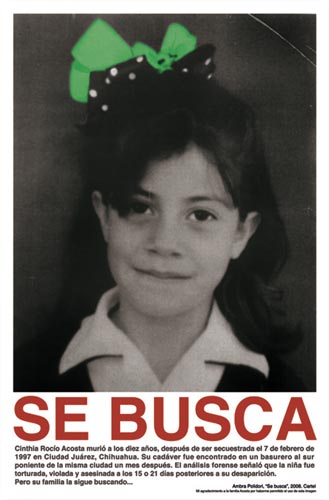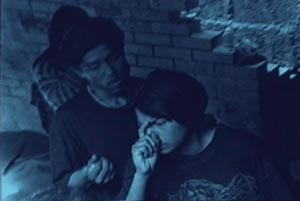To humanize history, “the little history,” to take care of it from the field of arts; put her skin back on to later flay it again with every artwork, is what I intend to do, so that each observer, each reader –and not passive viewers– can preserve the sensitivity that makes them worth of being called human.
Ambra Polidori
Ambra Polidori provokes the unconscious, that of ours, with the sting of her pupils. Her lucid camera is like a Freudian cabinet.
Néstor A. Braunstein

The exhibition Disagreements (Desacuerdos), at the Fototeca de Cuba, by Ambra Polidori (born in Mexico and of Italian descent) was one of the major photography displays ever showcased in our country. While we enjoyed works by Si Manuel Alvarez Bravo, Rene Burri, Robert Mapplethorpe, ShirinNeshat and Spencer Tunick, among others, over the last decade; the works of this renowned creator are now (September-October, 2010) brought to us so we can confirm her outstanding level.
I met the artist in Mexico –a common friend built the bridge from Valencia, Spain. Both Ambra and her husband, famous plastic artist Raymundo Sesma, had met Octavio Paz in person by the time when I was precisely studying the art critic of the great poet and essay writer. In a visit to the couple’s home, I looked through the pages of the catalogues of some of Ambra’s exhibitions, and soon I felt I had to invite her to exhibit in Cuba.
Let’s say that Ambra Polidori is not strictly a photographer, but an artist of the image and word in the widest extent of the term. Her conception of the image is avant-garde, postmodern, classical and revolutionary, all at the same time. She makes use of the image’s power to awaken awareness and sensitivity, to shake them. Likewise she uses the high expressive value of texts, the biting character of words to deploy her resounding visual messages. She plays, recycles and takes over and manipulates the image, couples it with language until shaking up dormant minds with the media’s disconcerting racketing and the market’s delightful buzzing.
Ambra Polidori’s work is an elaborated demand against iniquities of political systems, and abusive and cruel societies; her pieces, essentially intellectual due to their contents and concepts, are cries against unbearable situations of violence and social injustice, in favor of children and women, against factors that lead to hunger, and try to become a balance in the human being’s vulnerability in the face of power. Her purely critical photos, videos and installations seek to submit areas of her country’s reality to a relentless analysis –and those of other geopolitical areas– that deserve the disapproval of honest, educated people, of respectful people, no matter what their ideological leanings are.
We are looking at one of the best artists within critical and heretic art from the social point of view; whose work makes no formal or rigorous concessions, and are far from being cheap pamphlets, as it is in constant pursue of the essence and depth of art and real life. When Ambra Polidori recognizes the touting character that emerges in her work between what’s evident and what’s metaphorical, and between truth and fiction, she reveals her ars poetica [sic], that is, the key of her conception of art.
Reconsidering the grotesque nature of horror, violence and human pain based on an aesthetic formulation is one of the qualities of Polidori’s work. She is aware of the fact that in art, poetical elements can be of transient condition and that ephemeral quality, being an image, is resolved in her work by its fixed expressiveness and the strength of her representations. This way, the lyrical core of the motives and themes, or what is the same, the moving sensitivity of her images, protects the essence and poetic substance from time’s vicissitudes: her work would be long lasting, we could go into it and back, and it will certainly produce the same visual and emotional impact. It is like a gleam that grows from the art proposal’s intimacy into our eyes urging us to talk with the image, with its discourse.
Photography’s capacity to serve as testimonyand the author’s permanent questioning of the world and her time invaded the halls of the Fototeca de Cuba to leave the ever-lasting memory of one of the most powerful displays of the last few years. Ambra Polidori’s work will remain among the Cuban pu-blic as a legacy of deep humanism.
There was no better opportunity for this interview Polidori kindly granted to me.
Your work as a critic and essay writer began in Lápiz, Unomásunoand other important publications; could you tell me about this period?
I haven’t long finished my Major in Spanish language and literature at the National Autonomous University of Mexico and I had taught those subjects at a prep school, when I had the opportunity to work in a new daily, Unomásuno, founded and directed by Manuel Becerra Acosta –who boasted a coveted intuition and journalism knowledge–and a great team of journalists most of them coming from the Excelsior newspaper –from where they had been fired. This was a progressive daily that was the direct result of a political reform that legalized the left and started to open the Mexican authoritarian oyster late in the 1970s. It was a much more critical daily as compared with the media we were used to in Mexico. I started in the cultural supplement, named Sábado, directed by Fernando Benitez, in charge of the long interviews of great Mexican writers such as Juan Jose Arreola, Jorge Ibargüengoitia, Efrain Huerta, etc. And, later as feature writer I collaborated with the cultural section writing mostly about plastic arts and photography. From there, I went on to work in a few magazines like Spanish Lápiz, specializing in contemporary art.
 How did you move to photography?
How did you move to photography?
I had been taking pictures for awhile, but being in close contact with several artists and photographers because of my job at Unomásuno increased my interest and the time I spent on photography until I dedicated myself to it full time. This was by the mid eighties.
Your first themes dealt with the body and its metaphors, later with deeper social concerns, could you talk about this development?
I can’t explain what happened exactly. Truth is that in 1997 my work started to move in a new direction –partly because of personal reasons and a death-related experience. My work started to address the unease in the world, wars, diseases, exploitation... Nudes continued to be present, but in a different way, and I began to use in addition to my own pictures, images from the press and the television. That’s how the series: Beyond any reasonable doubts (Más allá de toda duda razonable)emerged.
However, I can see that your approach through the images is closely related with the deepest literary or intellectual thoughts on the themes you tackle artistically. I’m thinking right now about your images regarding the work of Austrian writer and philosopher Ludwig Wittgenstein. How does this new and complex view emerge?
It is likely related with my literary education, with my readings, my travels and my encounter with philosophy and in particular with my discovering of Wittgenstein’ proposals which I started to include in my works, for example, in the series Notes about colors (Observaciones sobre los colores), a title that paraphrases that of the book by the Viennese philosopher that refers to colors not in the physical or psychological sense, but from the viewpoint of the language philosophy. In the same way, I didn’t deal with the series of color, as the works were in black and white, I played with their meaning in a different way, one that had to do with questioning those who were on the margin (the marginalized, whether because of the race, ideology or a war). It is hard to explain why one decides to do one thing or another in art, you usually work by intuition, at least that’s how I do it, though I do as much research as I can about what I want to do.
Your work addresses current pressing problems of the Mexican reality and the world, you protest and denounce inequities. Do you consider art should always embrace this sense of dialogue with reality?
I think many artists reflect in their work the world they live in. It could be a world of doubt, show, racial or ideological conflicts, banality, violence, etc. Yes, in many artists there is that continuous dialogue with reality. Others would rather express emotions or inexplicable things. I believe that real artists are always in dialogue with their reality and that can also be that of madness or of a visionary.
 How do you see today’s state of Mexican photography?
How do you see today’s state of Mexican photography?
There are many men and women photographers in Mexico at present, and several spaces for photography exhibitions, be it traditional or with a more avant-garde sense in terms of proposals and big formats. There are some authors with great proposals–in the art field, for example, there is Gabriel Orozco or in journalistic photography those who look for social and symbolic reconstruction like Marco Antonio Cruz and Pedro Valtierra– and talented young artists like Maya Goded, Federico Gama, Adela Goldbard and Daniela Edburg, among others.
Tell me about your work Desacuerdos that you brought to Havana, to the Fototeca de Cuba, what is your goal?
I sought, on one hand, to give a “general” idea of a broad period of my work including works I did in a not so recent past, since I had never exhibited in this country; and on the other hand, I wanted to produce works especially for Cuba. This way, I show social and political concerns about topics like violence and the media; death of women and girls in Ciudad Juarez, Chihuahua, Mexico; a football game in which the ball is a god and the show is what counts; children exploitation and victimization, and governments that repeat themselves always oblivious to the promise of true commitment with the people they are about to lead. And a series of installations like “freedom of the press” and its manipulation; the children rights focusing in the paragraphs dealing specifically with exploitation, including sexual, in the metaphor of a dream that flies after them, and island emptied from itself, in search for other lands...
Related Publications

How Harumi Yamaguchi invented the modern woman in Japan
March 16, 2022












